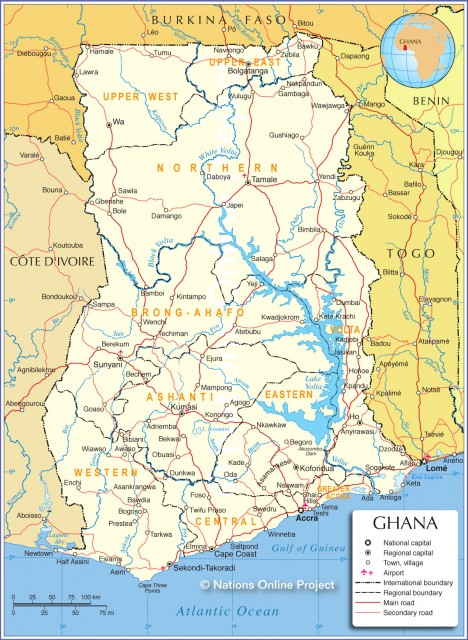Ghana
Area 92,090 square mi (238,500 square km)
Population 26.44 million (2014)
Capital Accra
Highest Point 2,904 ft (885 m)
Lowest Point 0 m
GDP $38.65 billion (2014)
Primary Natural Resources gold, bauxite, diamonds, hydropower.
GHANA IS LOCATED in west-central Africa and is bordered by COTE D'IVOIRE to the west, TOGO to the east, and BURKINA FASO to the north. The Gulf of Guinea of the ATLANTIC OCEAN washes Ghana's southern shore. Ghana, formerly called the Gold Coast, was a British colony until March 6, 1957, when it gained independence. A country slightly smaller than the state of OREGON, it became the first nation in sub-Saharan Africa to gain political independence from a European colonial power. A densely populated and lowland country, its main export was the production of cocoa, with a little mining, at independence. It supplied the chocolate industries in Europe with their important raw material, cocoa. It assumed the name Ghana at independence and began to play an important role in African struggle for independence and national liberation.

Flat plains and gently rolling hills characterize Ghana. Its forests cover 28 percent of the country's area, while 26 percent is farmed. The country is divided into five distinct geographical regions. Coastal plains stretch across the southern portion of the country, featuring low sandy beaches interspersed with saltwater lagoons. A forested plateau region consisting of the Ashanti uplands and the Kwahu Plateau is located inland, in southwest and south central Ghana. The hilly Akwapim-Togo Ranges run north to south along the country's eastern border. While the Volta Basin takes up most of central Ghana, high plains characterize the northern third of the country. Its main river is the Volta, which is formed in the center of the country by the confluence of the Black Volta and the White Volta.
The Volta enters the Gulf of Guinea at Ada in southeastern Ghana. The construction of the Akosombo dam in 1961 on the Volta formed Lake Volta. The lake covers an area of 3,275 sq mi (8,482 sq km), making it one of the world's largest artificial lakes. The two major tributaries of the Volta are the Oti and Afram rivers. Together, the rivers drain the Volta Basin. Ghana's other significant river systems are the Densu, Birim, Pra, and Ankobra. All empty into the Gulf of Guinea. Ghana's rivers are navigable only by small crafts, with the exception of the Volta.
Southern Ghana contains evergreen and semi-deciduous forests, consisting of tall silk cottons, kolas, and valuable West African hardwoods such as mahogany, odum, and ebony. About two-thirds of the country is covered by savanna characterized by shea trees, acacias, and baobabs. Oil palm is found throughout the south and the Ashanti uplands, and the lagoons of the coast contain mangroves. Once plentiful throughout the savanna, large mammals such as elephants and lions are now rare and largely confined to nature reserves. The forest regions are habitats for monkeys, snakes, and antelopes. Some of its major rivers contain crocodiles. There are more than 725 bird species in Ghana.
Ghana is a tropical country with distinctive wet and dry climate seasons (with regional variations). The north experiences one long rainy season from March until November, when a hot, Saharan wind known as the harmattan blows from the north and brings the dry season. The south experiences two rainy seasons: one from April to July, and then—after intermittent rains in August—another from September to November. The northern part, like in Nigeria, is drier than the south, with the exception of the coastal area around Accra.
Despite continuous migration into urban areas, 64 percent of the population still resides in rural communities. The main occupations in the rural areas are farming, herding, and fishing. In the cities, most people work in the service sector or in manufacturing. The country's major cities are Accra, the national capital; Kumasi, the principal city of the Ashanti region; Tema, an industrial city and Ghana's major port; Sekondi and Takoradi, the coastal twin cities; Tamale, a northern trade center; and the college town of Cape Coast.
Upon independence in 1957, Kwame Nkrumah tried a socialist economic reform without success. Ghana, like most developing countries, has witnessed many military interventions, which invariably hampered development. As such, it experienced severe economic decline as a result of political instability. By the mid-1980s, however, economic recovery programs were put in place to encourage and expand private sector investments and more important, to satisfy both the International Monetary Fund and the World Bank reform programs. Since the mid-1980s the government has promoted industries using local raw materials and private investment in food production. Since 1990, Ghana's economy has grown at an average of 4.2 percent each year.